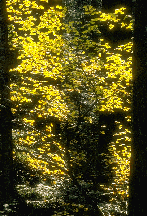Please read the pages indicated by Z-20 and study Behavioral Objectives 31 and 32. The biomes south of the taiga do not form such a definite circumglobal belt as do the tundra and the taiga. There is more variation in the amount of rainfall at this latitude, and consequently, more variation in the types of climax communities that predominate in parts of the temperate zone.
 Where
rainfall is abundant and summers are relatively long and warm, as they are
in most of the eastern United States, most of central Europe, and part of
eastern Asia, the climax communities are frequently dominated by
broad-leaved trees. Such areas in which the foliage changes color in
autumn and drops are called the deciduous forest biomes. They
characteristically include many more species than the taiga to the north.
Locate on the earth where this biome is located by studying the map
showing the biomes of the world.
Where
rainfall is abundant and summers are relatively long and warm, as they are
in most of the eastern United States, most of central Europe, and part of
eastern Asia, the climax communities are frequently dominated by
broad-leaved trees. Such areas in which the foliage changes color in
autumn and drops are called the deciduous forest biomes. They
characteristically include many more species than the taiga to the north.
Locate on the earth where this biome is located by studying the map
showing the biomes of the world.
Activity: Write a paragraph describing which environmental factors are responsible for the characteristic adaptations demonstrated by the plants and animals in the temperate deciduous forest biome and give examples of the flora and fauna which may be found in this ecosystem’s trophic levels.
Where temperate zone precipitation ranges from about 10 to 150 cm annually, temperate deciduous forest develop. These habitats are dominated by broad/leaved hardwood trees that ______________.
- a. lose their leaves annually.
- b. retain their leaves year round.
- c. drop their leaves every five years.
- d. live for only a few years.
In the temperate zone, the deciding factor is producing forest versus grassland is usually __________.
Created by the Multimedia Development Lab, Academic Technology Services.
Last modified November 19, 1997.